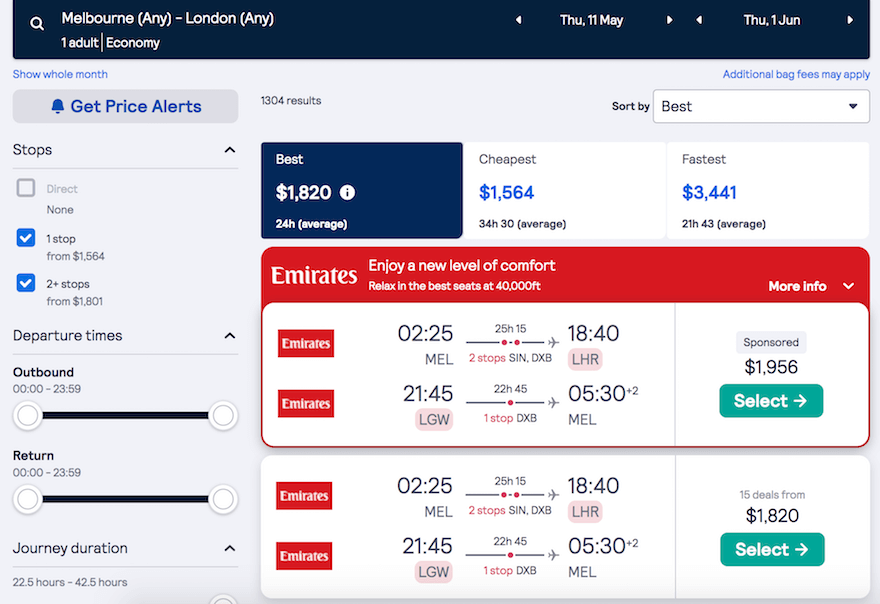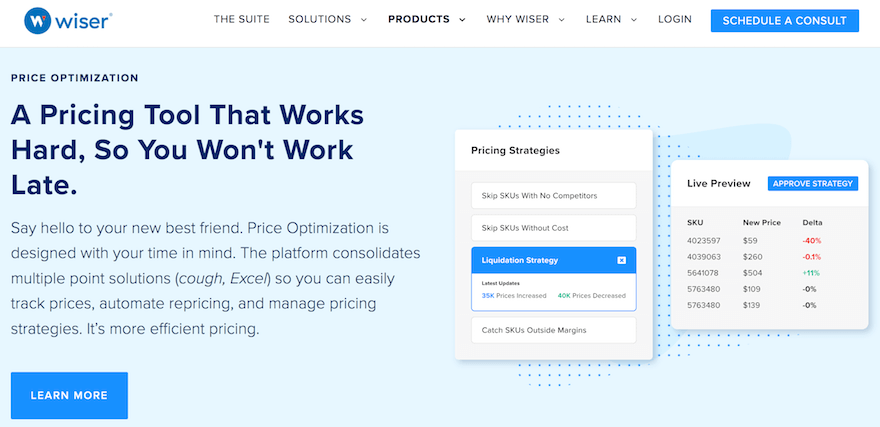Revolutionizing Pricing Strategies: The Power of AI in Dynamic Pricing
Our independent research projects and impartial reviews are funded in part by affiliate commissions, at no extra cost to our readers. Learn more
Is there anything artificial intelligence can’t do? Between AI website builders, AI blog writers, and AI marketing tools, AI’s influence on how we create, sell, and so much more is stronger than ever. AI’s growth shows no sign of slowing down, and there’s no denying the transformative effect it’s having on all aspects of how you run your business.
With dynamic pricing AI, you can take the hassle out of pricing your products or making adjustments to respond to supply, demand, topical events, or market conditions. AI does it all in real time like a high-powered analyst that doesn’t need to eat, sleep, or take time off.
Sound good? Let’s explore what AI dynamic pricing is, why it matters, and how to implement it – then look at what trends we can expect going forward.
Understanding Dynamic Pricing
Dynamic pricing is a strategy in which online stores adjust prices for goods and services – in real time – based on factors such as supply, demand, competitor prices, and other market conditions.
The goal? To maximize your store’s revenue by taking advantage of market fluctuations.
Popular across a range of industries – including ecommerce, travel, hospitality, and ride-sharing – dynamic pricing allows you to keep your rates competitive when demand is low and boost sales when it’s high. And, with AI, dynamic pricing has got a whole lot easier.

The AI Advantage in Dynamic Pricing
AI-driven dynamic pricing is powered by artificial intelligence algorithms and machine learning models.
This technology can sort and sift through vast swathes of data – far more and far quicker than any teams of human analysts could – to make automated pricing decisions.
These systems’ key advantage? Their capacity to learn.
After crunching the numbers of those huge datasets – which include information on market demand, competitor pricing, and even external factors such as weather or topical events – machine learning models don’t simply make decisions. They learn from them: synthesizing every piece of data they’ve touched, and every choice they’ve made, into their approach to make them more accurate and effective going forward.
Because they can learn, AI dynamic pricing models can also predict, identifying patterns and trends to anticipate future changes in demand or market conditions. With these kinds of forecasts and foresight, your business can make proactive adjustments to your pricing strategies in real time – ensuring each decision is grounded in data, rather than hunches.
Implementing AI-Powered Dynamic Pricing
Now we’ve covered what dynamic pricing is, and why AI can give it an edge, let’s look at how your business can go about implementing an AI-powered dynamic pricing strategy.
We’ve split the process up into three distinct steps.
Step #1: Collect and Process the Data
All AI systems – no matter what you’re using them for – rely on data to be effective. This means any AI tool is only as good as the information you’re able to feed into it.
Your first step, then? Collecting that data.
Gather historical sales data from your business, along with all information you keep about your customers. Be sure, too, to obtain information about your key competitors’ pricing, as well as any other relevant market indicators.
Then, you’ll need to process that data. To do this, there’s a huge array of data processing techniques at your disposal – including cleaning, transformation, aggregation, sampling, filtering, and deduplication – to help clean, organize, and structure your data for analysis.
Step #2: Build and Refine AI-driven Dynamic Pricing Models
Next up? Developing an AI model, and incorporating machine learning algorithms suitable for dynamic pricing. Some machine learning algorithms tailored to dynamic pricing include:
- Regression models: these draw on historical data to predict numerical values – such as optimal pricing – going forward.
- Classification models: these enable personalized pricing strategies – so, those tailored to the individual preferences of your customers – by categorizing data for segmentation.
- Reinforcement learning: this is the technique of training models to make pricing decisions through trial and error, and learn from the consequences of past decisions.
If building and training your own AI-driven dynamic pricing technology sounds like something that’s easier said than done, you’re right – and, unless you’re a data scientist or AI expert yourself, we recommend seeking external advice here.
Of course, there’s also the option of going with an AI-driven dynamic pricing provider – a company that’s already developed this software, and that you can purchase a subscription from to add to your ecommerce store.
These providers include Quicklizard, Wiser, Intelligence Node, and Pricing Solutions.

If you do decide to go it alone, however, bear in mind that an AI-driven dynamic pricing model is like a Tamagotchi. It’s not enough to purchase it and let it sit there – it needs to be fed and watered with the only sustenance these models know: data. (And lots of it!)
Step #3: Align AI with Established Pricing Frameworks
The final step? Integrating your AI-powered dynamic pricing model into your existing systems, and ensuring they play nicely with your established pricing frameworks.
This will require you to evaluate your existing pricing setup and identify points of integration with your AI-driven dynamic pricing. This could be through API (Application Programming Interface) integration or data flow integration, both of which enable AI models to communicate with your existing pricing systems.
You’ll also need to ensure your AI models slot seamlessly into your business’s pricing strategy and goals while facilitating, and aligning with your broader commercial aims and ambitions.
To do this, you may need to implement change management strategies – to speed up and smooth over any cracks in your business’s adoption of AI dynamic pricing.
Make sure, too, to provide comprehensive training to your team members who will be using this technology, and equip them with all the knowledge they need to get the most out of your AI dynamic pricing setup.
Overcoming Challenges in AI-Powered Dynamic Pricing
AI dynamic pricing isn’t without its challenges.
So what barriers will your online business have to overcome to implement a successful AI-powered dynamic pricing strategy?
Let’s take a look.
Ethical Considerations
AI dynamic pricing can lead to personalized pricing based on individual customer data – which, inevitably, raises concerns about fairness and equity.
So striking the right balance – between tailoring prices to the individual’s willingness to pay and avoiding discrimination – is an ethical challenge any AI dynamic pricing strategy needs to overcome.
Customer Perception and Communication
The opacity of AI algorithms when it comes to pricing goods or services throws up its fair share of ethical dilemmas, too.
Customers may feel uneasy about your pricing if they feel it’s exploitative or unfair, and may question your pricing’s fairness – so be prepared to answer these queries as and when they crop up. Be sure, too, to communicate transparently about your pricing algorithms and how they offer value, explaining them clearly to dispel any consumer confusion or skepticism.
Mitigating Bias in AI Dynamic Pricing
Through no fault of their own, AI algorithms can perpetuate biases – all inherent in the data you’ve supplied them with – which may lead to discriminatory pricing based on factors such as purchase history or the customer’s demographic information.
Ensuring your pricing models are fair and unbiased across different customer segments is a challenge – and an ongoing one. To meet it, regularly audit and refresh your algorithms to identify and mitigate these biases, and ensure they’re fairness-aware and up to date.
Future Trends in AI-Powered Dynamic Pricing
AI dynamic pricing is already changing the way ambitious ecommerce and travel businesses jostle for an increasingly competitive slice of the market. But what does its future hold?
Here’s a whistle-stop tour of AI dynamic pricing’s future trends, for this year and beyond:
- AI dynamic pricing will only get better. With more advanced machine learning techniques – such as deep learning – on the rise, AI’s ability to predict pricing trends will only become more accurate. And, as AI continues to improve, it will enable businesses to make pricing adjustments more promptly – and respond even more rapidly to changes in market conditions and customer behavior.
- Explainable AI will skyrocket. Businesses, looking to address AI dynamic pricing’s transparency issues, will trend toward developing more explainable AI algorithms – creating models able to provide clear, understandable explanations for pricing decisions, and fostering greater consumer trust in the process.
- Expect to hear more about ‘dynamic bundling’. This form of AI dynamic pricing involves adjusting prices based on specific combinations of products or services. It’s an important revenue booster because it enables you to offer personalized packages tailored to your customers’ individual preferences – and we expect it to boom in the coming years.
- Ethical guidelines and standards will emerge to regulate the industry. With AI dynamic pricing a complex – and currently unregulated – sphere, prepare to see new ethical guidelines and industry standards set up to meet the challenge. Companies, too, will likely play an active role in shaping these regulatory frameworks to ensure AI dynamic pricing models are responsible and fair…
…so watch this space, and be prepared to get involved!
Dynamic Pricing AI: Summary
Implementing dynamic pricing AI offers a huge wealth of benefits for your business.
It can help you compete fiercely with your biggest rivals, boost revenue, and ensure a more personalized approach to selling online. Used well, AI can also improve the customer experience while drawing upon your business’s key data to help you make better, more informed pricing choices.
That said, AI dynamic pricing invokes that old SpiderMan quote – that “with great power comes great responsibility”. Yours is to ensure the data you’re feeding your AI dynamic pricing model is free of bias and as correct, and relevant, as possible. It’s important to also be as transparent as you can with your customers about how – and why – your prices keep changing.
Do that, and your business (not to mention its profit margins) will be set to play a big role in the ongoing AI revolution. The right side of it!
FAQs
For a closer look at this interesting – and wildly exciting – topic as it develops, head to our guide to AI in ecommerce.
To do this, you can employ techniques like competitor analysis, or through formulas that calculate your products’ overheads, then add a fixed markup percentage. For a (much!) more detailed take, we recommend exploring our guide to how to price a product.
Leave a comment